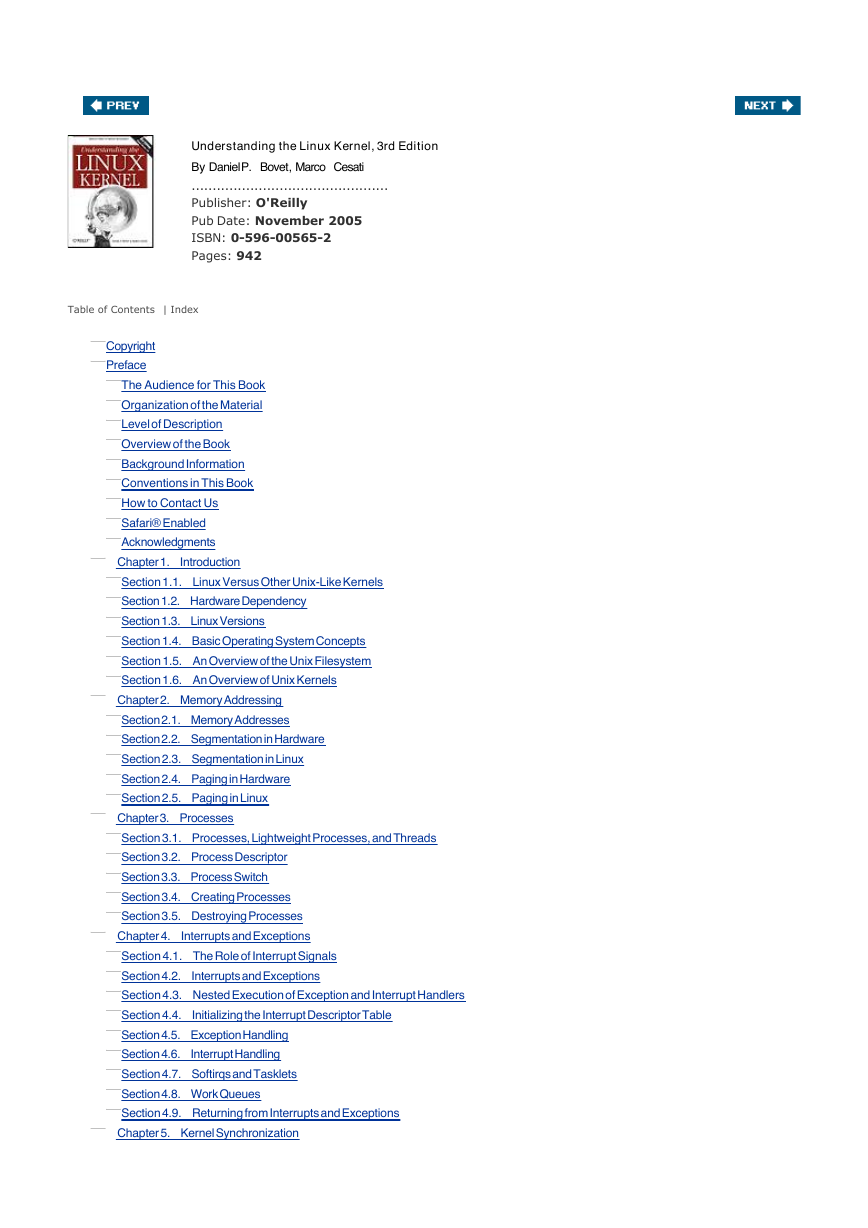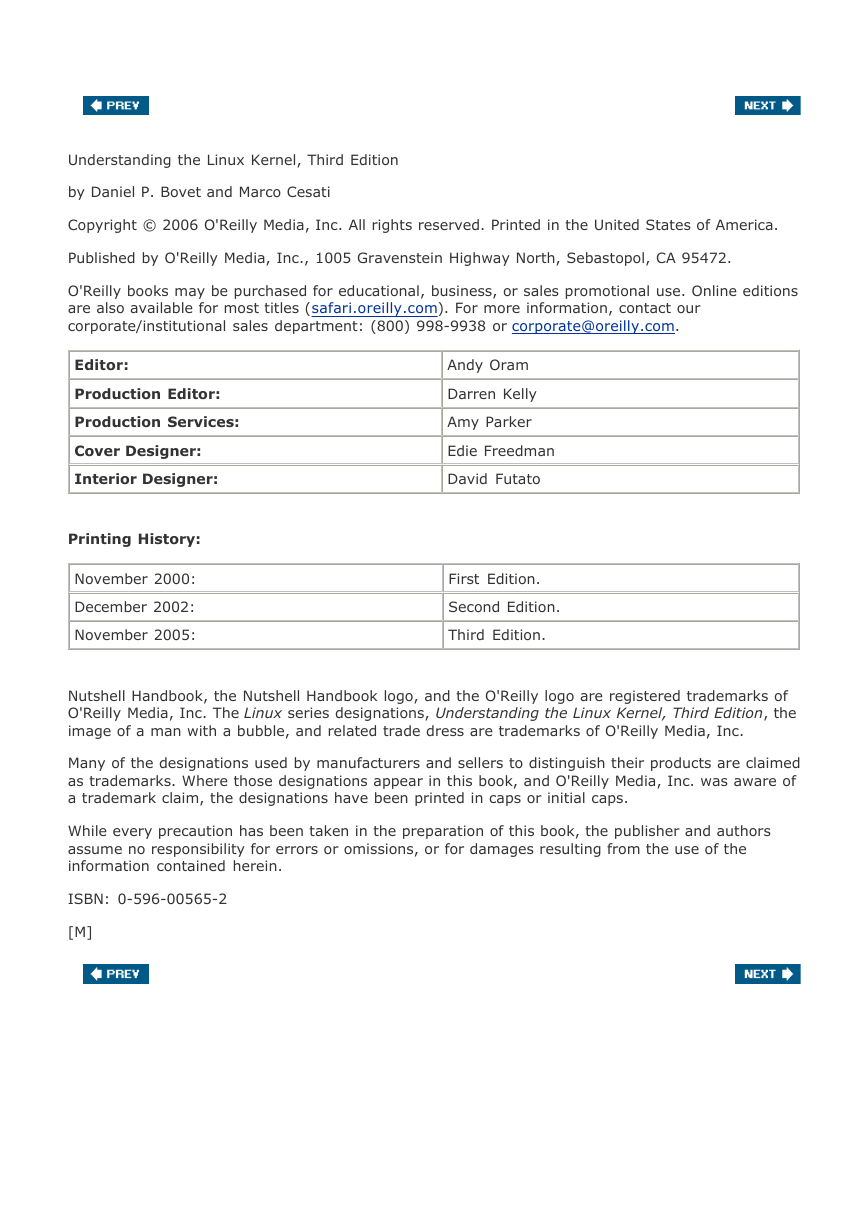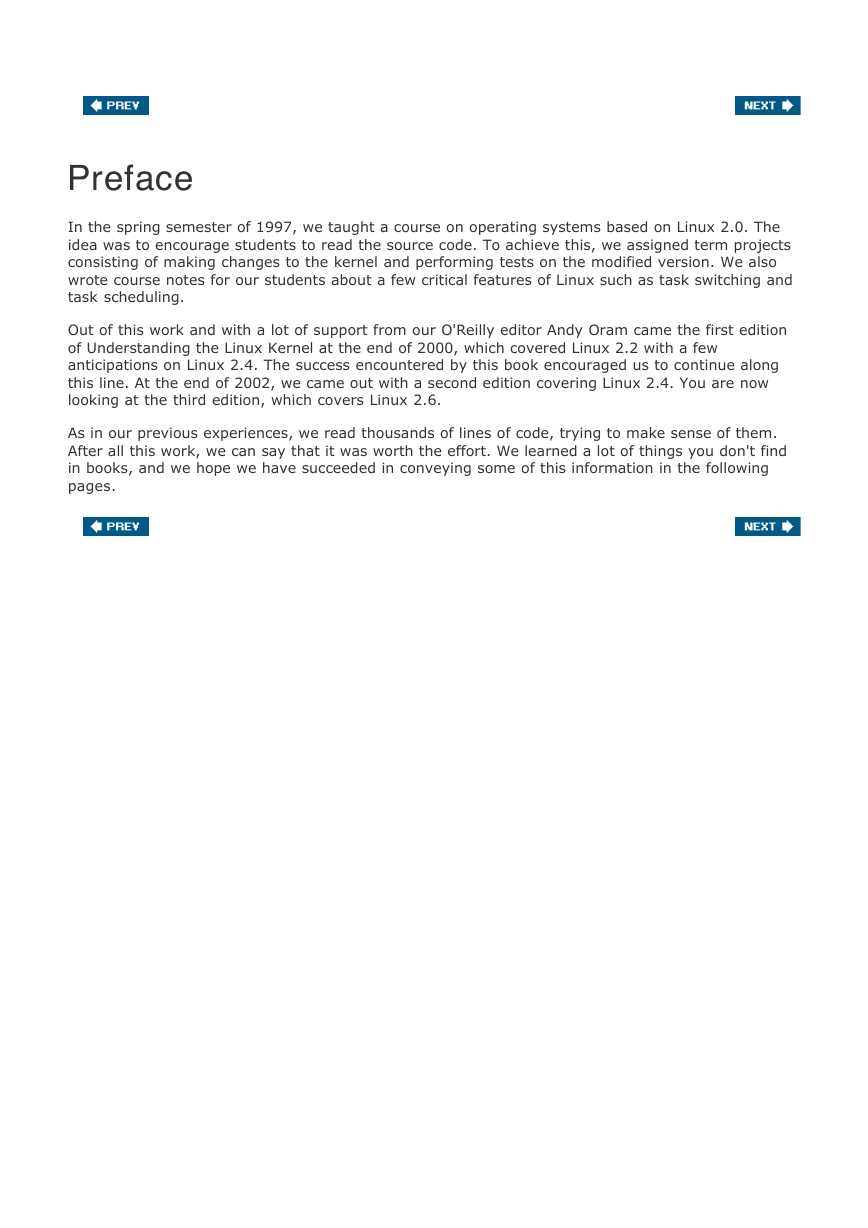Understanding the Linux Kernel, 3rd Edition
Table of Contents
Copyright
Preface
The Audience for This Book
Organization of the Material
Level of Description
Overview of the Book
Background Information
Conventions in This Book
How to Contact Us
Safari® Enabled
Acknowledgments
Chapter 1. Introduction
Section 1.1. Linux Versus Other Unix-Like Kernels
Section 1.2. Hardware Dependency
Section 1.3. Linux Versions
Section 1.4. Basic Operating System Concepts
Section 1.5. An Overview of the Unix Filesystem
Section 1.6. An Overview of Unix Kernels
Chapter 2. Memory Addressing
Section 2.1. Memory Addresses
Section 2.2. Segmentation in Hardware
Section 2.3. Segmentation in Linux
Section 2.4. Paging in Hardware
Section 2.5. Paging in Linux
Chapter 3. Processes
Section 3.1. Processes, Lightweight Processes, and Threads
Section 3.2. Process Descriptor
Section 3.3. Process Switch
Section 3.4. Creating Processes
Section 3.5. Destroying Processes
Chapter 4. Interrupts and Exceptions
Section 4.1. The Role of Interrupt Signals
Section 4.2. Interrupts and Exceptions
Section 4.3. Nested Execution of Exception and Interrupt Handlers
Section 4.4. Initializing the Interrupt Descriptor Table
Section 4.5. Exception Handling
Section 4.6. Interrupt Handling
Section 4.7. Softirqs and Tasklets
Section 4.8. Work Queues
Section 4.9. Returning from Interrupts and Exceptions
Chapter 5. Kernel Synchronization
Section 5.1. How the Kernel Services Requests
Section 5.2. Synchronization Primitives
Section 5.3. Synchronizing Accesses to Kernel Data Structures
Section 5.4. Examples of Race Condition Prevention
Chapter 6. Timing Measurements
Section 6.1. Clock and Timer Circuits
Section 6.2. The Linux Timekeeping Architecture
Section 6.3. Updating the Time and Date
Section 6.4. Updating System Statistics
Section 6.5. Software Timers and Delay Functions
Section 6.6. System Calls Related to Timing Measurements
Chapter 7. Process Scheduling
Section 7.1. Scheduling Policy
Section 7.2. The Scheduling Algorithm
Section 7.3. Data Structures Used by the Scheduler
Section 7.4. Functions Used by the Scheduler
Section 7.5. Runqueue Balancing in Multiprocessor Systems
Section 7.6. System Calls Related to Scheduling
Chapter 8. Memory Management
Section 8.1. Page Frame Management
Section 8.2. Memory Area Management
Section 8.3. Noncontiguous Memory Area Management
Chapter 9. Process Address Space
Section 9.1. The Process's Address Space
Section 9.2. The Memory Descriptor
Section 9.3. Memory Regions
Section 9.4. Page Fault Exception Handler
Section 9.5. Creating and Deleting a Process Address Space
Section 9.6. Managing the Heap
Chapter 10. System Calls
Section 10.1. POSIX APIs and System Calls
Section 10.2. System Call Handler and Service Routines
Section 10.3. Entering and Exiting a System Call
Section 10.4. Parameter Passing
Section 10.5. Kernel Wrapper Routines
Chapter 11. Signals
Section 11.1. The Role of Signals
Section 11.2. Generating a Signal
Section 11.3. Delivering a Signal
Section 11.4. System Calls Related to Signal Handling
Chapter 12. The Virtual Filesystem
Section 12.1. The Role of the Virtual Filesystem (VFS)
Section 12.2. VFS Data Structures
Section 12.3. Filesystem Types
Section 12.4. Filesystem Handling
Section 12.5. Pathname Lookup
Section 12.6. Implementations of VFS System Calls
Section 12.7. File Locking
Chapter 13. I/O Architecture and Device Drivers
Section 13.1. I/O Architecture
Section 13.2. The Device Driver Model
Section 13.3. Device Files
Section 13.4. Device Drivers
Section 13.5. Character Device Drivers
Chapter 14. Block Device Drivers
Section 14.1. Block Devices Handling
Section 14.2. The Generic Block Layer
Section 14.3. The I/O Scheduler
Section 14.4. Block Device Drivers
Section 14.5. Opening a Block Device File
Chapter 15. The Page Cache
Section 15.1. The Page Cache
Section 15.2. Storing Blocks in the Page Cache
Section 15.3. Writing Dirty Pages to Disk
Section 15.4. The sync( ), fsync( ), and fdatasync( ) System Calls
Chapter 16. Accessing Files
Section 16.1. Reading and Writing a File
Section 16.2. Memory Mapping
Section 16.3. Direct I/O Transfers
Section 16.4. Asynchronous I/O
Chapter 17. Page Frame Reclaiming
Section 17.1. The Page Frame Reclaiming Algorithm
Section 17.2. Reverse Mapping
Section 17.3. Implementing the PFRA
Section 17.4. Swapping
Chapter 18. The Ext2 and Ext3 Filesystems
Section 18.1. General Characteristics of Ext2
Section 18.2. Ext2 Disk Data Structures
Section 18.3. Ext2 Memory Data Structures
Section 18.4. Creating the Ext2 Filesystem
Section 18.5. Ext2 Methods
Section 18.6. Managing Ext2 Disk Space
Section 18.7. The Ext3 Filesystem
Chapter 19. Process Communication
Section 19.1. Pipes
Section 19.2. FIFOs
Section 19.3. System V IPC
Section 19.4. POSIX Message Queues
Chapter 20. Program ExZecution
Section 20.1. Executable Files
Section 20.2. Executable Formats
Section 20.3. Execution Domains
Section 20.4. The exec Functions
Appendix A. System Startup
Section A.1. Prehistoric Age: the BIOS
Section A.2. Ancient Age: the Boot Loader
Section A.3. Middle Ages: the setup( ) Function
Section A.4. Renaissance: the startup_32( ) Functions
Section A.5. Modern Age: the start_kernel( ) Function
Appendix B. Modules
Section B.1. To Be (a Module) or Not to Be?
Section B.2. Module Implementation
Section B.3. Linking and Unlinking Modules
Section B.4. Linking Modules on Demand
Bibliography
Books on Unix Kernels
Books on the Linux Kernel
Books on PC Architecture and Technical Manuals on Intel Microprocessors
Other Online Documentation Sources
Research Papers Related to Linux Development
About the Authors
Colophon
Index
A
B
C
D
E
F
G
H
I
J
K
L
M
N
O
P
Q
R
S
T
U
V
W
X
Z
















 2023年江西萍乡中考道德与法治真题及答案.doc
2023年江西萍乡中考道德与法治真题及答案.doc 2012年重庆南川中考生物真题及答案.doc
2012年重庆南川中考生物真题及答案.doc 2013年江西师范大学地理学综合及文艺理论基础考研真题.doc
2013年江西师范大学地理学综合及文艺理论基础考研真题.doc 2020年四川甘孜小升初语文真题及答案I卷.doc
2020年四川甘孜小升初语文真题及答案I卷.doc 2020年注册岩土工程师专业基础考试真题及答案.doc
2020年注册岩土工程师专业基础考试真题及答案.doc 2023-2024学年福建省厦门市九年级上学期数学月考试题及答案.doc
2023-2024学年福建省厦门市九年级上学期数学月考试题及答案.doc 2021-2022学年辽宁省沈阳市大东区九年级上学期语文期末试题及答案.doc
2021-2022学年辽宁省沈阳市大东区九年级上学期语文期末试题及答案.doc 2022-2023学年北京东城区初三第一学期物理期末试卷及答案.doc
2022-2023学年北京东城区初三第一学期物理期末试卷及答案.doc 2018上半年江西教师资格初中地理学科知识与教学能力真题及答案.doc
2018上半年江西教师资格初中地理学科知识与教学能力真题及答案.doc 2012年河北国家公务员申论考试真题及答案-省级.doc
2012年河北国家公务员申论考试真题及答案-省级.doc 2020-2021学年江苏省扬州市江都区邵樊片九年级上学期数学第一次质量检测试题及答案.doc
2020-2021学年江苏省扬州市江都区邵樊片九年级上学期数学第一次质量检测试题及答案.doc 2022下半年黑龙江教师资格证中学综合素质真题及答案.doc
2022下半年黑龙江教师资格证中学综合素质真题及答案.doc